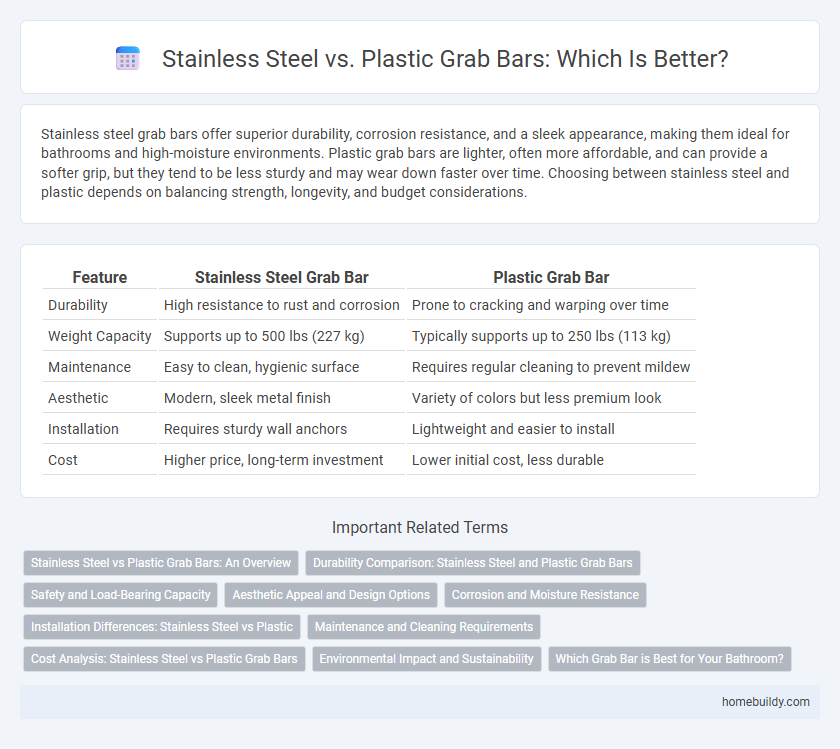Stainless steel grab bars offer superior durability, corrosion resistance, and a sleek appearance, making them ideal for bathrooms and high-moisture environments. Plastic grab bars are lighter, often more affordable, and can provide a softer grip, but they tend to be less sturdy and may wear down faster over time. Choosing between stainless steel and plastic depends on balancing strength, longevity, and budget considerations.
Table of Comparison
| Feature | Stainless Steel Grab Bar | Plastic Grab Bar |
|---|---|---|
| Durability | High resistance to rust and corrosion | Prone to cracking and warping over time |
| Weight Capacity | Supports up to 500 lbs (227 kg) | Typically supports up to 250 lbs (113 kg) |
| Maintenance | Easy to clean, hygienic surface | Requires regular cleaning to prevent mildew |
| Aesthetic | Modern, sleek metal finish | Variety of colors but less premium look |
| Installation | Requires sturdy wall anchors | Lightweight and easier to install |
| Cost | Higher price, long-term investment | Lower initial cost, less durable |
Stainless Steel vs Plastic Grab Bars: An Overview
Stainless steel grab bars offer superior durability and corrosion resistance compared to plastic grab bars, making them ideal for bathroom environments with high moisture levels. The strength of stainless steel ensures reliable support and longevity, while plastic grab bars may weaken or crack over time under similar conditions. Maintenance is easier with stainless steel due to its resistance to staining and bacteria buildup, enhancing both safety and hygiene.
Durability Comparison: Stainless Steel and Plastic Grab Bars
Stainless steel grab bars offer superior durability due to their resistance to corrosion, rust, and physical damage, making them ideal for long-term use in moist bathroom environments. Plastic grab bars, while more cost-effective and lightweight, generally lack the strength and longevity of stainless steel and are prone to cracking or warping over time. Choosing stainless steel ensures enhanced safety and extended lifespan, especially in heavy-use or commercial settings.
Safety and Load-Bearing Capacity
Stainless steel grab bars offer superior safety and load-bearing capacity compared to plastic grab bars, supporting weights up to 500 pounds or more without bending or breaking. Their corrosion-resistant properties ensure long-term durability in wet bathroom environments, reducing the risk of failure due to material degradation. Plastic grab bars generally have lower weight limits and may become brittle over time, posing a higher risk of accidents during use.
Aesthetic Appeal and Design Options
Stainless steel grab bars offer a sleek, modern aesthetic that complements contemporary bathroom designs, providing a polished finish resistant to rust and stains. Plastic grab bars, while available in various colors and shapes, often lack the premium look and durability that stainless steel delivers. The design options for stainless steel bars include brushed, polished, and matte finishes, allowing for seamless integration into high-end bathrooms.
Corrosion and Moisture Resistance
Stainless steel grab bars offer superior corrosion and moisture resistance compared to plastic grab bars, making them ideal for wet environments like bathrooms. Their durable alloy composition withstands prolonged exposure to water without rusting or degrading. Plastic grab bars, while resistant to moisture, can become brittle over time and may not provide the same long-term reliability in high-humidity conditions.
Installation Differences: Stainless Steel vs Plastic
Stainless steel grab bars require professional installation with secure mounting into wall studs to support heavy weight and ensure durability, while plastic grab bars often use suction cups or adhesive mounts that offer easier but less reliable attachment. The installation of stainless steel bars involves drilling and anchoring, making them more permanent and stable compared to plastic options which are prone to loosening or detaching over time. Choosing stainless steel bars enhances safety in bathrooms due to their solid fixation and resistance to wear, unlike plastic grab bars that prioritize convenience over long-term reliability.
Maintenance and Cleaning Requirements
Stainless steel grab bars offer superior durability and resist corrosion, making maintenance and cleaning easier with just mild soap and water, while plastic grab bars may degrade over time and require more frequent replacement. Their non-porous surface prevents bacterial buildup and withstands harsh cleaning agents, ensuring long-lasting hygiene. Choosing stainless steel reduces the need for frequent maintenance and guarantees compliance with safety standards in wet environments.
Cost Analysis: Stainless Steel vs Plastic Grab Bars
Stainless steel grab bars typically cost more upfront, ranging from $30 to $100 depending on size and finish, while plastic grab bars generally priced between $10 to $30 offer a budget-friendly option. Despite higher initial costs, stainless steel bars provide superior durability, corrosion resistance, and load-bearing capacity, reducing replacement and maintenance expenses over time. Plastic grab bars may require frequent replacement due to wear and lower structural integrity, potentially increasing long-term costs despite their lower purchase price.
Environmental Impact and Sustainability
Stainless steel grab bars offer superior environmental sustainability compared to plastic options due to their durability and recyclability, significantly reducing waste and resource consumption over time. The production of stainless steel involves higher initial energy use but offsets this through a longer lifespan and the ability to be fully recycled without degradation. Plastic grab bars, often made from non-biodegradable materials, contribute to environmental pollution and typically have shorter lifespans, leading to more frequent replacements and increased landfill waste.
Which Grab Bar is Best for Your Bathroom?
Stainless steel grab bars offer superior durability, corrosion resistance, and a sleek appearance, making them ideal for long-term safety in wet bathroom environments. Plastic grab bars, while more affordable and lightweight, often lack the strength and longevity required for reliable support during falls or slips. Choosing stainless steel ensures enhanced safety, easier maintenance, and compliance with ADA standards for bathroom assistive devices.
stainless steel grab bar vs plastic grab bar Infographic

 homebuildy.com
homebuildy.com